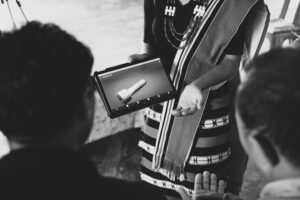
Decolonising the Museum:
Digital Repatriation of the Gaidinliu Collection from the UK to India
Who was Gaidinliu?
Gaidinliu (1915- 1993), a Zeliangrong Naga, was sixteen year old when she instigated an uprising against the British between 1929 and 1932 in the present Indian regions of Assam, Nagaland and Manipur. In their efforts to put down the rebellion, the British launched massive military operations in the Zeliangrong areas in search of Jadonang and Gaidinliu, the leaders of the rebellion. While Jadonang was arrested and executed in 1931, Gaidinliu was eventually arrested in 1932 after having evaded capture by hiding in various places. She remained incarcerated until her release after India’s independence in 1947. From the 1950s, until her death in 1993 she remained a prominent public figure, as the spiritual guide of the Heraka religious movement and as leader of the Zeliangrong People’s Convention for a Zeliangrong homeland within India. Since her death in 1993, Gaidinliu has become a celebrated figure in modern India and a prominent symbol of Indian independence.
What is the Gaidinliu Collection?
During the military operations to apprehend Gaidinliu and Jadonang and quell their anti-colonial rebellion, the British confiscated her notebooks, clothing, ornaments and various ritual objects. During their raids, the British forces also destroyed Heraka places of worship in villages such as Kambiron. A number of artefacts were also taken from these religious sites. Many artefacts were also taken from Hangrum, a village where Gaidinliu’s followers confronted British forces in a battle that left eight dead and many more injured. These objects, collected by various British officers during these military expeditions, were donated to the Pitt Rivers Museum, Oxford and are now known as the Gaidinliu Collection. The collection comprises of 28 artefacts. These include notebooks, ritual objects, personal ornaments and clothing items.
The Project
DiMuse is a four-year research project on the ‘repatriation’ of objects from the Gaidinliu Collection in the Pitt Rivers Museum (Oxford). The British took the collection over 90 years ago during colonial rule in Northeast India but it has never been on public display. Recently, it has taken on greater significance as Gaidinliu has become an icon in modern India, an important symbol of Indian independence. The conjuncture between current debates about the decolonisation of Western museums and the renewed prominence of Gaidinliu in India make this project especially pertinent and timely.
The aim of the project is to engage with the Zeliangrong Naga community in order to ‘return’ digital copies of the objects in the collection, to co-produce knowledge by interrogating the multiple meanings of the process, and to critically evaluate this form of repatriation as a way of decolonising the Western museum. The DiMuse project has five main interrelated objectives:
- To undertake the digital repatriation of digital copies of the Gaidinliu collection housed in the Pitt Rivers Museum, Oxford, to the Zeliangrong Naga community in Northeast India.
- To promote and facilitate dialogue between the current curators of objects in the Gaidinliu collection and contemporary members of the communities from which these objects were taken.
- To interrogate the process of digital repatriation and reveal the complex questions it provokes through the investigation of historical and contemporary encounters with Zeliangrong Nagas in Assam, and diverse audiences in India and the UK.
- To challenge colonial classifications of objects by revealing the multiple meanings in the Gaidinliu collection and uncovering the contested legacy of material culture.
- To critically evaluate the effectiveness of ‘digital repatriation’ in partnership with multiple stakeholders.
Ultimately, the project looks to address challenging questions regarding colonial extraction, historical context and the afterlives of the Gaidinliu objects in contemporary India and UK.